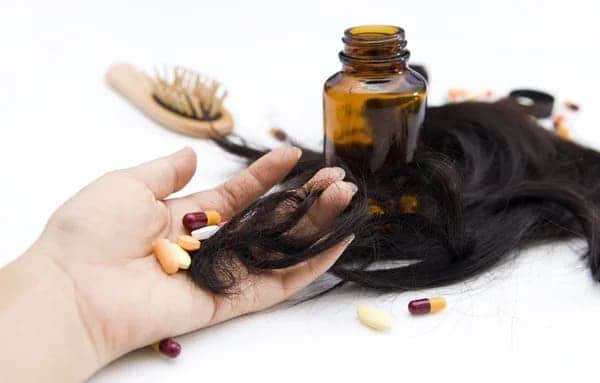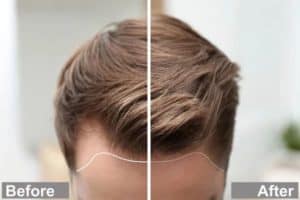Experiencing hair loss from chemotherapy can be one of the most stressful time during a person’s life. Hair loss is one of the most common side effects of this cancer treatment, affecting both men and women equally. On this post, you’ll find everything you need to know about chemotherapy induced alopecia prevention, and promoting new hair growth.
Why does chemotherapy cause hair loss?
Chemotherapy is one of the most populars forms of cancer treatments doctors use to treat cancer. It is designed to aggressively attack cancer cells in your body and prevent them from regrowing. One side effect of this, however, is that chemotherapy drugs can also attack other fast growing cells (like your hair follicles), causing hair loss.
During chemotherapy, patients have experienced different levels of hair loss. From thinning, to partial hair loss, to full baldness across the body, no chemotherapy patient will experience the same. Similarly, for some patients, hair loss can be permanent and for others, it can grow back. This is often dependent upon which treatment your doctor prescribes.
Chemotherapy treatments know to induce hair loss include: Altretamine, Carboplatin, Cisplatin, Cyclophosphamide, Docetaxel, Doxorubicin, Epirubicin, Fluorouracil, Gemcitabine, Idarubicin, Ifosfamide, Paclitaxel, Vincristine, and Vinorelbine.
Chemotherapy medication can, in some cases, result in hair loss across your whole body and the result can be permanent. Some hair transplant doctors would call this condition “chemotherapy induced alopecia universalis”.
If you’re worried about ever worried about cancer treatment and hair loss, be sure to speak to your doctor, or find a support group to talk to help you on your journey. If you’re reading this from the US, the American Cancer Society is a great way to find support group. If you’re in the UK, Macmillan is also well regarded!
How long does chemotherapy take to cause hair loss?
Once a patient is scheduled to begin chemotherapy, they will likely experience hair loss in the first 2-4 weeks of treatment.
During these first few weeks, there are a number of ways you may experience hair loss, from individual hairs to larger clumps. Some patients may wake up in a morning to find hair on their bed or pillow, some will experience hair loss during the shower, and others may simply notice more hair on their hairbrush.
Patients have even stated that hair loss may continue weeks after their treatment. In some cases, patients have suggested their new hair starts to grow around a month to six weeks after treatment.
What can be done to prevent hair loss from chemotherapy?
For patients only suffering with smaller amounts of hair loss, there are two main ways to treat hair loss. These include:
Chemical Treatments
Treatments such as Mixoxidil and Finasteride are a fantastic, clinically proven way to slow the effects of hair loss. Whilst this will not stop your hair loss altogether, as long as you take this, you will likely slow the process down . Chemical treatments help to increase blood flow to the scalp, helping hair follicles to produce healthier strands of hair.
Whilst a positive of chemical treatments is that they are easily accessible over the counter of many pharmacies and supermarkets, the downside is that they can often be quite expensive for people over the long term.
Scalp Cooling Cool Caps
This is a great way to slow down the hair loss process during a treatment (chemotherapy infusions) itself. A cool cap is a cap that patients will place on their head, chilling their scalp, and slowing down the blood flow to the head. In many ways, this works in the opposite way to chemical treatments. Whilst minoxidil will increase blood flow to the head, attempting to make your hair follicles stronger, a scalp cooling cap will decrease the blood flow, making the chemotherapy drugs less likely to circulate around your head and affect your hair.
However, whilst scalp cooling caps have been shown (admittedly, with mixed evidence) to work, this may increase your risk of cancer recurring, on your head, in the future. This is due to the chemotherapy infusions not being able to visit every part of the body, potentially leaving cancer cells around the scalp. Whilst this is rare, it may be something for you to consider.
Wigs and Head coverings
Wigs and head coverings are a personal choice for all patients undergoing chemotherapy medication. Whilst some choose to hide their hair loss, others may feel proud that they are going through the process! That being said, wigs are still one of the most popular forms of combatting hair loss during chemotherapy. For many patients who have suffered with extensive hair loss, an investment in a high quality wig may help to combat feelings of anxiety about appearance. With a wig, some patients feel more confident in going out in public without feeling self-conscious about how they look during treatment.
One key benefit of wigs is that new products are consistently begin brought to market with more realistic looking, and lightweight wigs being developed every couple of months. In cancer patients, “monofilament wigs” appear to be the most popular choice. These wigs are lightweight and made out of a breathable fabric, limiting any chance of irritation or itchiness.
Will hair regrow after chemotherapy treatment?
Hair regrowth after chemotherapy is dependent upon a number of different factors, namely individual differences between patients and treatment type. For patients who have not been burdened with permanent alopecia, your hair will begin to regrow 4-6 weeks post chemo.
Once your hairs begins to regrow, short hair will take between 2 and 3 three months to grow. Providing you’re comfortable with sharing your situation with your hairdresser or barber, there are plenty of styles your could style with shorter hair.
For those with long hair, a full recovery could take anything up to a year. For those whose hair grows at a quicker rate, it is not uncommon for longer styles to grow in 9 months. However, to reduce further hair loss post chemotherapy, we recommend some styling practices (using hair dryers, curling irons, or tight ponytails) should be avoided. This will help your new hair grow strong and healthy.
Do I need a hair transplant after chemotherapy?
Whilst most patients tend to make a full recovery with post-chemo hair growth, it is not uncommon for there to be some bumps in the road ahead. Many patients have come to our clinics wishing for a hair transplant.
A hair transplant is entirely possible after having chemotherapy but there are some important factors to consider. Generally, hair transplants need between 1,500 and 3,000 spare hair follicles (from your scalp) that can be transplanted into an affected area.
If a patient has permanently lost all of their hair, then a hair transplant is not possible. Donor hairs can only be take from the back of the scalp, and so body hair hair cannot be used.
However, some form of permanent hair loss can be treated. If a patient only has partial hair loss, then a hair transplant can be performed. If you have had a particularly stubborn area on your head where hair falls out relentlessly, then we can certainly help!
Thanks to the success of a treatment called Follicular Unit Extraction (FUE), we can also perform eyebrow transplants and beard transplants. If you have suffered with permanent facial hair loss during your chemotherapy, then an FUE hair transplant may give you a solution!









